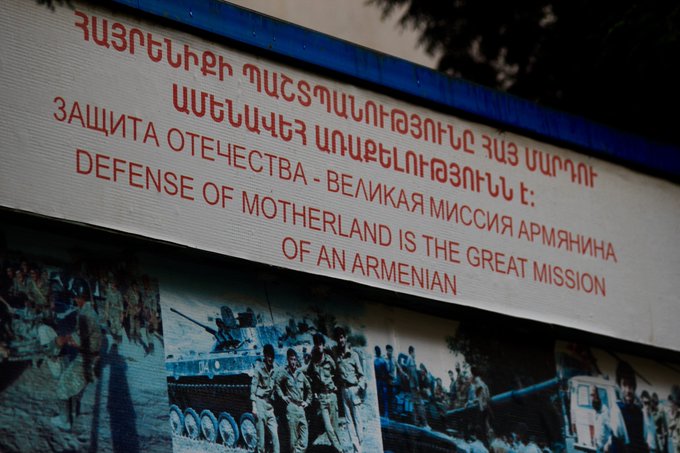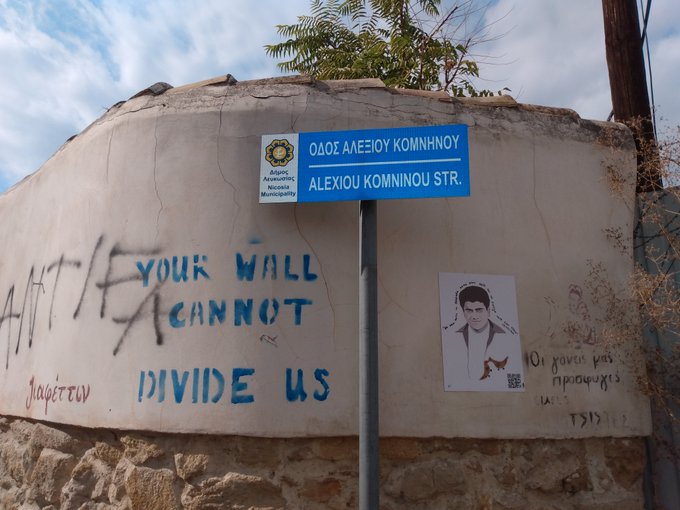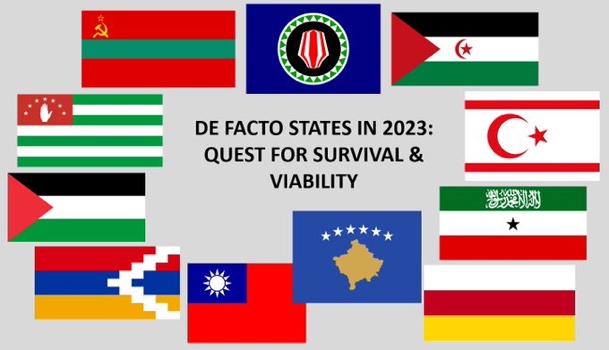The Final Chapter of Nagorno-Karabakh Republic
The de facto statehood of the Artsakh/Nagorno-Karabakh Republic (NKR) ended in September of this year, with Azerbaijan gaining full control of the breakaway region over the local Armenian population. Shortly after Azerbaijan’s military offensive, the Karabakh Armenians accepted the terms of the ceasefire, agreeing to dissolve their armed forces and starting negotiations with the Baku administration. The dissolution of the NKR led to the demise of its leadership and paved the ground for the ethnic cleansing of the 100,000 ethnic Armenians. The arrest of many NKR leaders, both past and present, together with the refugee crisis, have created severe challenges for Armenia’s leadership, questioning the fate of the Karabakh Armenians and the security challenges for Armenia ahead. This blog post will address these issues without getting into the historical and standing geopolitical details of the conflict.
Towards the end of Nagorno-Karabakh’s de facto statehood
2020 saw the beginning of the end of Karabakh Armenians’ de-facto statehood, the history of which is marked by significant human and territorial losses, ethnic cleansing and immense human suffering for the parties involved. After launching a military offensive in September 2020, Azerbaijan regained control over a large portion of NKR and the majority of the surrounding districts within 44 days. A ceasefire mediated by Russia ended the war, contingent on Russian peacekeepers’ presence in NKR. Despite the significant losses and the uncertain status of the NKR, its self-governance, albeit shrunken, continued. The situation was exacerbated following Russia’s 2022 full-scale invasion of Ukraine. In particular, encouraged by Russia’s distraction and focus on Ukraine and emboldened by its strategic partnership with the EU for energy security, Azerbaijan began applying more pressure on NKR. Under the guise of environmental activism, it imposed a blockade on NKR in December 2022, intending to cut the enclave’s only supply route via the Lachin corridor. It refused to lift the blockade in defiance of the International Court of Justice’s (ICJ) order.
Throughout the nine-month blockade, Azerbaijan’s ultimatum, coupled with its military built-up near the contact line, suggested increased efforts to regain total control over the region by force. The situation was deteriorating against the background of talks between Azerbaijan and the local Armenian authorities, as well as disagreements between Armenia and Azerbaijan over the terms of the November 9 ceasefire, specifically on the matter of opening up regional transportation connections through the Zangezur corridor. Eventually, against the backdrop of the grim humanitarian crisis brought on by the blockade, Azerbaijan launched an offensive over the breakaway region on September 19 of this year. The attack in NKR, referred to as a “local anti-terrorist operation” by official Azerbaijani authorities, rested on the casus belli of mine explosions that day that claimed the lives of four police officers and two civilians.
Following a day of fighting and bombardment of civilian infrastructure in NKR, the de facto authorities agreed to surrender. The first round of talks between Azerbaijani authorities and Karabakh Armenian leaders took place in Yevlakh. A week later, the de facto authorities signed a decree on the dissolution of the NKR, which would be effective by the start of 2024, formally ending more than 30 years of de facto statehood. This also signified a dramatic change in Russia’s narrative of “frozen conflicts,” in support of Azerbaijan while abandoning the NKR, which its peacekeepers were supposed to protect. Russia’s changing position on the matter, as illustrated by Laurence Broers, an associate fellow at the London-based Chatham House’s Russia and Eurasia Program, demonstrates a significant “Russian decline and the realignment of regional power.”
The ethnic cleansing of the Karabakh Armenian population
The Azerbaijan’s takeover of NKR caused a severe humanitarian crisis for local Armenians. The gradual process of the ethnic cleansing started in 2020 and was completed on September 30, 2023. Following Azerbaijan’s opening of the border, around 100,000 Karabakh Armenians fled the region for Armenia proper, many of those fleeing hungry, exhausted and in need of immediate assistance. In addition to the casualties from Azerbaijan’s offensive, during the exodus, a massive explosion at a fuel depot claimed the lives of around 217 people, wounding hundreds more. Moreover, at least 64 people lost their lives while on the road during the exodus.
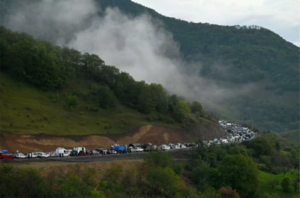
Image: Vehicles carrying refugees head out of Nagorno-Karabakh towards the Armenian border on 25 September 2023 (Source: David Ghahramanyan/Reuters)
Even though Baku avoided subjecting departees to serious interrogations or checks, as refugees crossed the Lachin Corridor in an attempt “to avoid being accused of ethnic cleansing,” it did not free itself from charges of ethnic cleansing. While this topic stirred heated debates, one may consider the UN definition of ethnic cleansing, which deems it “a purposeful policy designed by one ethnic or religious group to remove by violent and terror-inspiring means the civilian population of another ethnic or religious group from certain geographic areas.” The exodus of the Karabakh Armenians was anything but voluntary; it occurred as a result of the deployment of starvation tactics against them during the months-long blockade and the launch of the offensive on the starved population by Azerbaijan. Notably, the International Criminal Court’s (ICC) founding chief prosecutor, Luis Moreno Ocampo, has described the blockade with its consequences as “genocide”. Following Baku’s regaining control of the territory, per Armenia’s request, the ICJ concluded in its November 17 decision (pending a final decision in the case) that Azerbaijan must ensure that people who left Nagorno-Karabakh after September 19 and wish to return “are able to do so in a safe, unimpeded, and expeditious manner.”
Baku showcased extreme cynicism with its strategy of handing food and drinks to some fleeing civilians in front of the flashing cameras months after weaponizing hunger and attacking NKR. This strategy, as much as cynical, effectively conveys Baku’s efforts to portray a different picture of itself to the outside world. Despite this, the exodus was explicitly acknowledged as ethnic cleansing by some actors, including but not limited to the European Parliament, German Bundestag’s Foreign Affairs Committee. Baku’s military operation was condemned by the US, EU, PACE. Nevertheless, the international community’s inaction ultimately revealed tolerance for use of force to recover territorial integrity, despite its grave outcome of ethnic cleansing of the entire Karabakh Armenian population. The EU’s accommodative stance towards Baku’s aggression is also attributed to its strategic partnership with Azerbaijan. The tangible outcomes were limited to the provision of humanitarian aid and efforts for additional support to bolster Armenia’s resilience against threats to its territorial integrity.
After the above events, Azerbaijan granted permission for a group of observers from the United Nations Resident Coordinator Office and other senior agency officials to conduct a monitoring mission in the recently regained territory. The visit and the following statement was received in Armenia merely as a propaganda attempt by Baku, as the statement released after the visit stressed that there was no evidence of violence against civilians, failing to adequately address the context of the ethnic cleansing and the humanitarian crisis. The fact that diplomats led the visit from Azerbaijan’s friendly nations accredited in Baku, such as Turkey, Russia, Hungary, Pakistan, and Albania, was also brought to light, questioning their credibility. Although the exact number of Armenians still living in Nagorno-Karabakh is unknown, according to Tigran Grigoryan, a local political analyst, the number may be as few as 50. Actual footage from Stepanakert, the capital of NKR, formerly home to 50,000 people but now looked more like a ghost town, was captured by an Al Jazeera television news crew, which arrived in Karabakh alongside the mission.
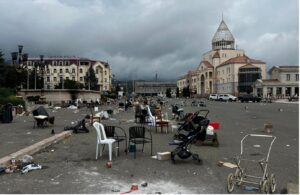
Image: Abandoned Stepanakert (Source: Telegraph)
The fate of the NKR leadership
Following the takeover of NKR, Azerbaijan detained many high-ranking Armenian officials in Karabakh and filed serious charges against them in Azerbaijani courts, raising concerns about “victor’s justice”. While Azerbaijan sees the situation as a long-overdue moment of justice, Armenians see it as retaliation in a politicised legal system, which cannot offer a fair trial for its own subjects, let alone Armenians. The first one arrested was Russian-Armenian businessman and philanthropist Ruben Vardanyan, who served as the former State Minister of NKR for a while. Vardanyan was placed in a 4-month detention awaiting trial on terrorism-related charges. Next, the detention of Davit Babayan, the former foreign minister of Nagorno-Karabakh, who announced on Facebook that he would be handing himself over to the Azerbaijani soldiers, was confirmed by Azerbaijan. Currently, he faces 25 different charges, mainly related to separatism and terrorism.
To continue, three former presidents of NKR, Arkadi Ghukasyan (1997–2007), Bako Sahakyan (2007–2020), Arayik Harutyunyan (2020–2023), and the Speaker of the National Assembly, Davit Ishkhanyan, were also among the detainees. Arayik Harutyunyan has been charged under nine articles of the Criminal Code of Azerbaijan, amongst other things, referring to the “creation and participation in illegal armed organisations, providing them with weapons and ammunition, as well as for smuggling and financing terrorism.” He is also accused of “shelling residential areas and civilian objects in the Azerbaijani city of Ganja and the Barda region.” Bako Sahakyan, Davit Ishkhanyan, and Arkady Ghukasyan were charged under a number of articles, such as terrorism, acquisition of illegal weapons, and creating illegal armed groups. Other detentions included the former deputy commander of the armed forces of NKR, Davit Manukyan, who faces charges of terrorism, creating illegal armed groups, and illegally crossing the border, and the former defence minister of NKR, Levon Mnatsakanyan, now accused of torturing Azerbaijanis during the NKR’s de facto rule.
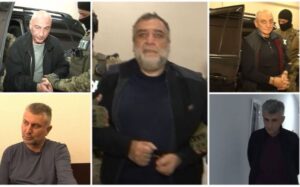
Image: NKR’s de facto leadership arrested (Source: Turkic World)
Interestingly Azerbaijan allowed Samvel Shahramanyan, the last president of NKR, to Leave Karabakh On October 4. He later appeared in front of the investigative committee of Armenia’s parliament to address questions on the details how the former presidents of Nagorno-Karabakh were captured. As per the statement released by the Ministry of Foreign Affairs, Armenia condemned these arrests pledging to take all possible steps “to protect the rights of the illegally arrested representatives of Nagorno-Karabakh.” It has also petitioned the ICJ. Nevertheless, it is not easy to imagine how exactly Armenia would be able to achieve those objectives without any international pressure.
Azerbaijan’s plans for “reintegration” of Karabakh Armenians
One of the most significant issues at hand is the fate of the Karabakh Armenians who found refuge in Armenia, as well as the few remaining Armenians in Karabakh (mostly elderly and sick). While the Azerbaijani government has made pledges to reintegrate these Armenians following its victory, it has not offered any detailed roadmap for this. One underlying issue is that Azerbaijan does not recognise dual nationality, while the ethnic Armenian population in Karabakh has Armenian citizenship. Azerbaijan has established an online portal enabling Karabakh Armenians to apply for residency, but according to Azerbaijan’s State Migration Service, it might not be accessible in Armenian just yet.
Azerbaijan has also released footage from Migration Service claiming it had already begun accepting documents from Karabakh Armenians living in Stepanakert wishing to accept Azerbaijani citizenship. Nevertheless, some people have cast doubt on this. However, even if true, the small numbers may not signify the beginning of the integration process, despite Baku’s attempts to suggest otherwise. Armenians in Karabakh have little to no reason to believe Azerbaijan’s promises to protect their rights and security as potential new citizens. As Laurence Broers noted in a conversation with Radio Free Europe “The Karabakh Armenians are not just any minority. They have a specific history of conflict, and they have very serious security concerns. So, I think a project to reintegrate them into Azerbaijan would require painstaking negotiations, transitional arrangements, real thinking about security guarantees, and so on (…) What we’re seeing is that these negotiations are taking place after very severe and asymmetric episodes of violence.” After all, confidence and trust take a long time to build, and no significant steps have been taken in this direction.
Even if Baku’s statements were taken at face value, it is difficult to imagine a scenario in which it can provide such guarantees to Karabakh Armenians, who have been the subject of anti-Armenian propaganda and hateful discrimination for decades. This is especially true given Azerbaijan’s poor human rights record, demonstrated by the Freedom House reports, which has only deteriorated in recent times. Thus, without genuine confidence-building efforts or international presence on the ground, a provision that Baku adamantly rejects, there is little to no chance that Karabakh Armenians will be able to return to their ancestral lands. Within this context, it is worth mentioning that many viewed a very recent agreement of a prisoner swap along with many other steps to “build confidence” between Azerbaijan and Armenia as a first step toward a possible peace agreement; however, it is too soon for high hopes. The threat of Azerbaijan’s military takeover of southern Armenia, under the pretext of getting access to Zangezur corridor, keeps the prospect of new rounds of violence and rivalry between Armenia and Azerbaijan very much alive.
Discussions on NKR government in exile
In his first address to the public after the NKR’s dissolution, the last president of Nagorno-Karabakh, Samvel Shahramanyan, rejected the decree he had signed, claiming that no document can dissolve a “republic created by the people”. Later in October, he had a closed meeting in Yerevan with several former officials as well as public and political figures from NKR and Armenia to discuss the issue of “preserving the statehood” of NK. The Committee for the Preservation of Artsakh Statehood, which was established by Armenian opposition leader Suren Petrosyan, arranged the meeting. Petrosyan had previously declared that the committee’s goals were to protect Nagorno-Karabakh’s institutions, support the recognition of the Armenian population’s right to self-determination, and guarantee their safe return to their homeland. While following the gathering, Shahramanyan declined to respond to media questions, Petrosyan stated that the process would continue. One of the meeting attendees, Ara Zohrabyan, a right-wing Armenian opposition figure, said the decree on the dissolution had no legal force and that the president could not dissolve a state that “became independent by referendum”. This was followed by a number of statements from ex-MPs from NKR, reiterating concerns over the subject in reaction to the Armenian government’s rather reluctant stance on the matter.
According to some analysts, the Armenian government sees the possibility of forming NKR in exile as risky, given Baku’s potential discontent on the matter. State officials’ statements repeatedly mirrored such worries. Alen Simonyan, the speaker of the Armenian Parliament, stated in mid-November that setting up a government in exile would pose a “direct threat and a blow to Armenia’s security.” Furthermore, in late November, Armenian President Vahagn Khachaturyan questioned the necessity of such an initiative, stating, “there is a Republic of Armenia, whose institutions are functioning”. Pashinyans’s recent statements on the “inevitability” of Nagorno-Karabakh’s dissolution due to the negotiation status his government inherited after coming to power in 2018 reiterated this position. Thus, Karabakh Armenians lack the backing of the Armenian authorities to establish a government in exile, primarily out of fear of Baku’s reaction. The subject becomes more and more relevant considering the growing socio-economic issues of the Karabakh Armenian population and Armenia’s security challenges. This may become a serious factor determining the domestic political situation in the next months or years in Armenia, defining power-struggle moments within the country.
The Armenian leadership’s response to the refugee crisis
The loss of Nagorno-Karabakh was not only a moment of profound trauma for the Armenian people, marking the end of the Karabakh Armenians’ millennium-long existence in their ancestral lands, but it also presented multiple challenges for the Armenian government and people. Specifically, many difficulties were brought about by refugee crisis, such as housing, food, and medication provision. Many individuals found shelter in various regions of Armenia, either with the assistance of their relatives and friends or government-provided temporary shelters. The volunteers welcomed the refugees in the nearby village of Kornidzor and Goris town. The government pledged to take all necessary steps to address the financial needs of the refugees and define their status, the latter being one of the most challenging issues. It authorised the establishment of a “temporary protected status” for displaced people.
The law automatically applies to those Karabakh Armenians who fled following Azerbaijan’s takeover of NKR on 19-20 September, the other option was to seek Armenian citizenship. This news took aback many Karabakh Armenians since they assumed they were already citizens because they had Armenian passports since 1999. According to Artyom Sujyan, an advisor to the minister of justice, the passports were issued as international travel documents under an agreement between the ministers of internal affairs of the Republic of Armenia and the NKR. Nevertheless, doing so would render them ineligible for the social assistance provided to those registered as refugees.
The challenges created by the complex situation concerning the end of NKR and the refugee crisis reflected back on Pashinyan’s popularity. Alongside longstanding critiques of Pashinyan’s strategic miscalculations since the beginning of his leadership regarding the Karabakh issue, as well as series of events leading to the deteriorating relations with Russia, without finding viable alternatives in the West, the uncertainty over security matters fuels this. According to the results of the survey presented by MPG, the Armenian representative of the Gallup International Association, more than half of Armenians do not trust Prime Minister Nikol Pashinyan to this or that extent. Answering the question: 35.5% was completely distrustful, 12.3% of the respondents found it difficult to answer. Those numbers, while reflecting the deteriorating position of Pashinyan’s rule, cannot explain what stands for it ahead. The Pashinyan administration has already persevered through several trying moments and maintained its hold on power, primarily due to the lack of a strong political opposition that might provide a robust and forward-thinking vision for the future of Armenia unrelated to any former political personalities. However, as long as this condition remains unfulfilled, Pashinyan’s “peace agenda”, as much as it is perceived to reflect his position of weakness, leaving Armenia vulnerable to Azerbaijan’s threats, offers more than any other unsubstantiated “promises” and “hopes” about Nagorno-Karabakh offered by the current opposition.
Author: Sevanna Poghosyan


